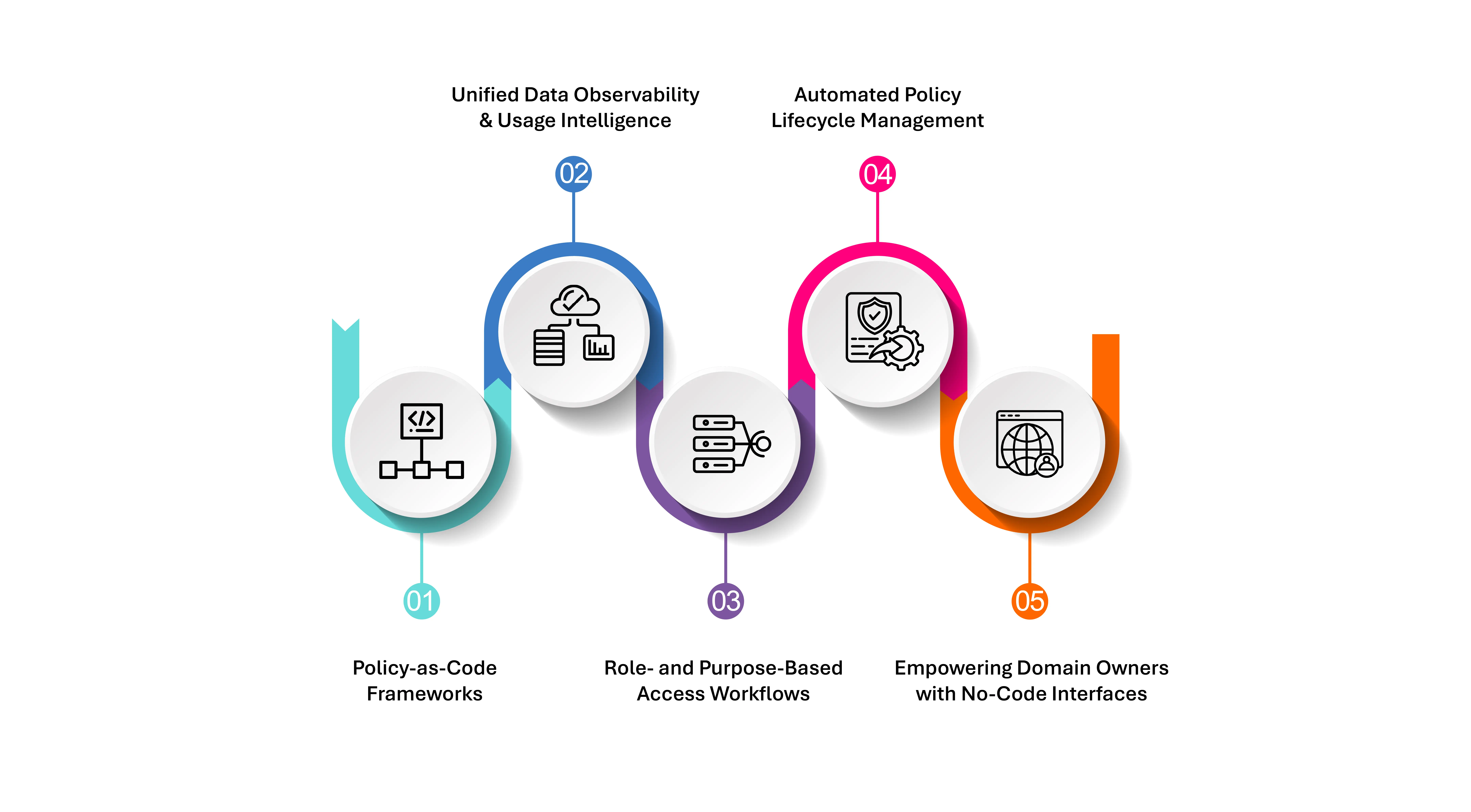What is Personalized Data Policy Creation & Workflow?
Personalized Data Policy Creation & Workflow refers to the ability to design, implement, and automate data governance policies that are tailored to specific datasets, user roles, risk levels, regulatory requirements, and business processes. Unlike static, one-size-fits-all rules, personalized policies are dynamic, context-aware, and adaptable, enabling precise control over how data is accessed, used, retained, or deleted across the enterprise.
Why It Matters in 2025
In the era of AI, hybrid cloud, and data localization mandates, enterprises can no longer rely on blanket policies or manual enforcement. Regulatory complexity, decentralized data ecosystems, and rising privacy expectations demand fine-tuned governance mechanisms that reflect the real-world nuances of how data is used. Personalized policy workflows empower organizations to bridge the gap between data security, compliance, and business agility.
Think: one policy engine, hundreds of personalized workflows—driven by real-time context, user identity, and data classification.
Key Capabilities and Use Cases
- Role-Aware Policy Assignment: Automatically apply different retention, access, or encryption policies based on a user’s department, geography, or seniority.
- Regulation-Responsive Workflows: Align policies with region-specific mandates like GDPR, CCPA, HIPAA, or DPDP, and adapt in real-time as laws evolve.
- Dynamic Risk-Based Triggers: Modify policies based on data sensitivity, risk score, or abnormal user behavior (e.g., stricter controls for IP or PII data).
- Lifecycle Management Automation: Initiate workflows based on metadata signals—e.g., auto-archive after 3 years, auto-delete if inactive, or flag for review.
- Audit-Ready Visibility: Provide end-to-end traceability of every policy decision, change, and enforcement action for compliance reporting.
Complexity, Context, and Control: Evolving Challenges in Policy Personalization

As enterprises scale across geographies, departments, and cloud environments, policy creation is no longer a static, one-size-fits-all task. It must be dynamic, context-aware, and tailored to specific data types, use cases, and regulatory obligations. Yet organizations often struggle with policy overload, legacy tool constraints, and the sheer fragmentation of data ecosystems.
Some of the key pain points include:
- Policy Sprawl: With multiple teams creating overlapping or conflicting rules, enforcement becomes inconsistent and difficult to audit.
- Low Visibility into Data Usage: Without unified observability, enterprises can’t customize policies based on how data is actually accessed or used, leading to blind spots and noncompliance.
- Static Workflows in Agile Environments: Traditional policy engines can’t keep pace with CI/CD pipelines or evolving AI workflows, creating friction between compliance and innovation.
- Lack of Role-Based or Purpose-Based Policy Customization: Many organizations cannot dynamically tailor data workflows based on who is accessing the data and for what purpose, an essential feature in Zero Trust or ethical AI frameworks.
To stay ahead, leading organizations are moving toward policy-as-code models, AI-assisted policy authoring, and workflow automation platforms that empower data owners—not just IT—to create and enforce guardrails that are granular, adaptable, and responsive to real-world usage.
Strategic Solutions: Turning Policy Complexity into Autonomous Governance

Solving the challenges of personalized data policy creation requires more than patchwork fixes—it demands a shift toward intelligent, integrated, and decentralized governance. Enterprises that treat policy not as a static artifact but as a living, evolving framework will be better equipped to thrive in a high-stakes, AI-driven digital economy.
Here’s how leading organizations are addressing these challenges:
- Policy-as-Code Frameworks: By expressing data policies as machine-readable code, enterprises can standardize, automate, and version-control policies across diverse environments. This approach enables continuous integration of governance into DevOps pipelines and reduces the risk of misconfiguration or drift.
- Unified Data Observability & Usage Intelligence: Embedding observability into data pipelines helps organizations monitor how data is accessed, used, and moved—empowering them to dynamically tailor policies based on actual behavior, not assumptions. This visibility also supports ongoing compliance validation and contextual policy enforcement.
- Role- and Purpose-Based Access Workflows: Modern platforms are incorporating contextual access models, where data workflows adjust dynamically depending on the user’s role, location, or intended purpose. This is critical for enforcing Zero Trust, data minimization, and ethical AI principles at scale.
- Automated Policy Lifecycle Management: Smart policy engines now support full lifecycle automation—from creation to enforcement to expiry. Trigger-based updates, AI-assisted recommendations, and policy sandboxing allow organizations to test, deploy, and refine policies with greater agility and lower risk.
- Empowering Domain Owners with No-Code Interfaces: Governance no longer needs to be owned exclusively by IT. Self-service platforms with intuitive UI/UX allow business units and data stewards to define and adapt policies without deep technical expertise, distributing accountability while maintaining central oversight.
By combining these capabilities, enterprises can transition from reactive, fragmented governance to autonomous, scalable, and resilient policy management—one that aligns with strategic priorities such as compliance, innovation, and digital trust.
Governance as the Guardrail: Operationalizing Trust in Autonomous AI Systems
As AI-driven systems increasingly automate decision-making across the enterprise, governance can no longer be a passive afterthought—it must be embedded by design. Personalized policy workflows serve as the ethical and operational foundation that guides AI behavior, ensuring systems act within predefined legal, risk, and business constraints. From determining what data a model is allowed to train on to how long outputs are retained and who has access, this layer of intelligent governance transforms compliance from a checkbox into a strategic advantage, making AI not just faster but more transparent, defensible, and aligned with enterprise values.
Getting Started with Data Dynamics:
- Learn about Unstructured Data Management
- Schedule a demo with our team
- Read the latest Use Case: Privacy in Action: Automating Subject Access Requests with Zubin






